Best anatomy books for artists

The best anatomy books for artists explain complex structures through visual language and present information systematically. This is the big difference between finding references on the internet or anatomy textbooks intended for medical students. I’ve compiled a list of the best books on animal and human anatomy for artists in this blog.
How to study anatomy for art the best way
One of the best ways to study animal and human anatomy for art is through books intended for this purpose – they feature reliable references that let you understand anatomical structures and observe their forms and movements. Of course, having a live model in your training would also make a big difference, but one is rarely available.
At first glance, the internet seems full of anatomy references, but you very quickly discover that you’re missing out on many important details. In contrast, the best anatomy books for artists mentioned in this blog are put together in such a way that lets you really understand animal and human anatomy. This, in turn, frees you from always copying references and enables you to be more creative.
1. Anatomy for Sculptors handbooks by Uldis Zariņš
Anatomy for Sculptors handbooks give visual artists everything they need to create realistic human body forms – from head to toe. Being a dyslectic student, in the 2000s I developed a systematic approach to translating medical anatomy texts into visual information that I could use while sculpting. I used the same system in my books, and now the Anatomy for Sculptors handbooks are bestsellers among visual artists striving to better understand the human form.
Anatomy for Sculptors: Understanding the Human Figure
Anatomy for Sculptors: Understanding the Human Figure contains visual references for hundreds of body postures and motions. Regardless of what composition you choose for your artwork, this book has everything you need to create realistic forms of the human body from head to toe.
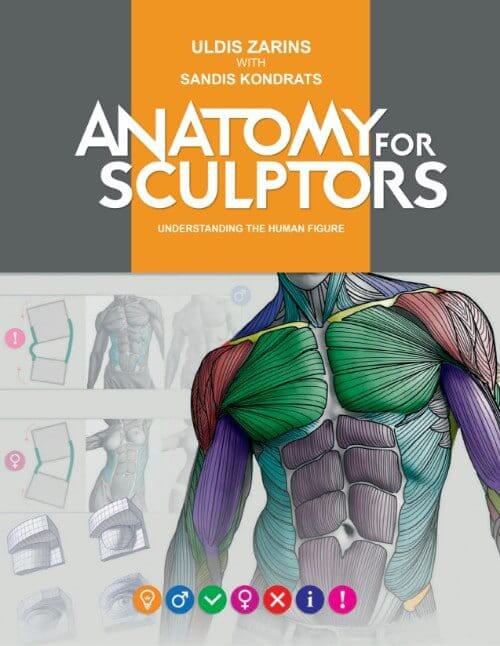
Anatomy of Facial Expression
Anatomy of Facial Expression makes it much easier for artists to understand facial anatomy – often the most challenging area of human anatomy to master. The book features 3D models and pictures of live models. It also uses the Facial Action Coding System to label images. This helps you understand each facial expression better by breaking it down into multiple action units.

Form of the Head and Neck
Form of the Head and Neck explains the relationship between the human head’s visible appearance and the anatomy beneath it. In most cases, facial muscles are not the ones that define the form of one’s face. Instead of making up the face’s surface volumes, muscles only move the surface forms from underneath the skin.This book shows you how factors such as age, ethnicity, gender, and body type affect the form of one’s face.
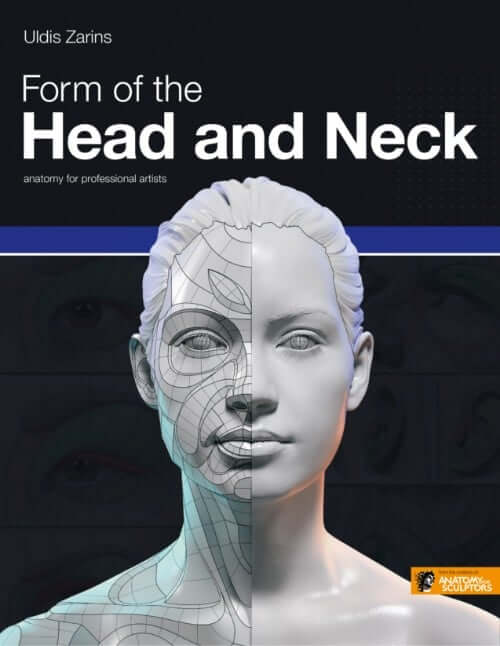
2. Der nackte Mensch by Gottfried Bammes
While the West was busy with postmodernism, the Soviet world cultivated social realism based on the 19th-century figurative tradition of the École des Beaux-Arts in Paris. East Germany was no exception, with its own figurative tradition at Dresden Academy of Fine Arts. Gottfried Bammes was a professor of art there, and he further developed classical anatomy studies by introducing a more scientific approach. Illustrations in Der nackte Mensch are precisely measured and reliable, and each of them introduces a new way to look at human anatomy. Concepts such as wire-framing and splitting organic form into geometric shapes appear here. This book is full of ideas, and it has been a huge influence on how I perceive human anatomy. Gottfried Bammes is, in my opinion, the greatest anatomist of the 20th century!
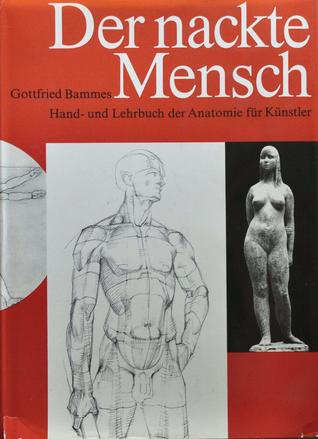
3. Human Anatomy for Artists by Eliot Goldfinger
Eliot Goldfinger’s book is very precise, reliable, and not too lengthy. Its systematic approach reminds me of a medical anatomy book, but it has been adapted for artists. Human Anatomy for Artists is consistent in its depictions of human anatomy, and you will find each anatomical structure depicted from set angles: front, side, top, etc. It’s not always easy to find reliable human anatomy references, but this is one of them.

4. Strength Training Anatomy by Frédéric Delavier
Frédéric Delavier is an artist and a bodybuilder, and he’s written a unique book. Although Strength Training Anatomy is popular with the bodybuilder audience, it is very useful for visual artists as well. Instead of just showing muscles in static positions, this book emphasizes motion and demonstrates how muscles look when being worked.

5. Artistic Anatomy: The Great French Classic on Artistic Anatomy by Dr. Paul Richer and Robert Beverly Hale
Dr. Paul Richer was a professor of artistic anatomy at École des Beaux-Arts at the beginning of the 20th century, and Robert Beverly Hale, an American artist and instructor of artistic anatomy, translated Richer’s text and extended it with his own valuable commentary. Artistic Anatomy: The Great French Classic on Artistic Anatomy is an absolute classic. It’s somewhat similar to Goldfinger’s book, only with a more significant emphasis on the movements of upper and lower extremities. It’s got precise drawings of the skeleton, side-by-side drawings that show anatomical structures with and without the skin. Side-by-sides help you recognize anatomical structures in real life. I got a lot of inspiration from this work when I made my book.
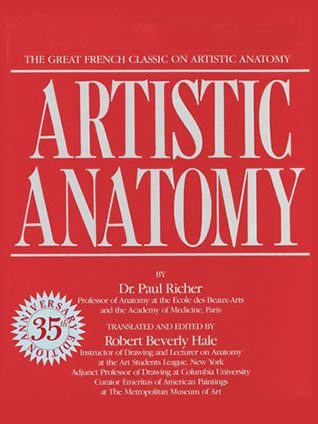
6. Drawing the Head and Hands by Andrew Loomis
Andrew Loomis worked in editorial and advertising in 1930s America. At the time, most skilled artists were preoccupied with experimenting and high art. Meanwhile, the growing consumer culture required a lot of professional artists to work also on advertisements. Drawing the Head and Hands by Andrew Loomis is a manual meant to explain complicated human anatomy concepts in a simple manner – a sort of an ABCs for visual artists. It’s an excellent book for beginners!

Anatomy for 3D artists
I have to say right away that the way you learn human anatomy and what references and handbooks you use don’t change much, regardless of what kind of visual artist you are. Besides learning anatomy, 3D artists might also find it helpful to look at other digital sculpting examples and study how different artists arrange their meshes and organize their workflows. That’s exactly why I put this next book on the best anatomy books for artists list.
7. Anatomy for 3D Artists: The Essential Guide for CG Professionals by 3dtotal Publishing
Anatomy for 3D Artists: The Essential Guide for CG Professionals compiles contributions by different authors and aims to cater to the specific needs of 3D artists. This book is arranged more like a classic textbook rather than a handbook, and the fact that it’s a compilation of contributions makes it a bit eclectic. However, the big plus of this book is the digital sculpting examples found in it. They let you observe how people approach different sculpting challenges and learn how to arrange meshes better. The authors don’t offer any insights into organizing their workflows, though. Overall this is a good book, but you should probably get it after you’ve acquainted yourself with the books mentioned earlier in this Best anatomy books for artists blog.

Animal anatomy for artists
Artists who understand human anatomy already know a thing or two about animal anatomy. Take a look at this photo we posted on Anatomy for Sculptors social media: the color code showcases how similar the segmentation of facial muscles of humans and dogs is.

Animal and human facial muscles comparison.
But of course, you still need good references of animal anatomy. This section will show you three of the best anatomy books for artists focused on animals. It includes a book with precise and systematic depictions of animal anatomy, a book with some real-life examples that have more flesh and volume, and a book that shows you animal anatomy in motion.
8. Animal Anatomy for Artists: The Elements of Form by Eliot Goldfinger
This Eliot Goldfinger’s book is similar in its approach to his book on human anatomy. Animal Anatomy for Artists: The Elements of Form is equally precise, systematic, and consistent in its depictions of anatomical structures as his book on human anatomy I mentioned earlier on this blog. While this is by far the best book about animal anatomy, I wish the illustrations were more spacial and also depicted movement. All the animals here are static. Human and animal anatomy have a lot in common, and knowing one helps learn the other. You can tackle the challenge of muscle depiction from various angles by studying spacial illustrations of human muscles in the Anatomy for Sculptors books.
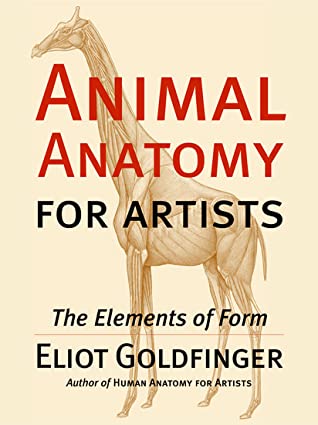
9. An Atlas of Animal Anatomy for Artists by Wilhelm Ellenberger
While Goldfinger’s book on animal anatomy gives schematic depictions, An Atlas of Animal Anatomy for Artists by Wilhelm Ellenberger features real-life examples of animal anatomy. These let you understand the forms better, but it’s not always easy to comprehend what’s depicted in them. That’s why I would advise using this book just to supplement the previous book on the list.

10. The Art of Animal Drawing: Construction, Action Analysis, Caricature by Ken Hultgren
The Art of Animal Drawing: Construction, Action Analysis, Caricature is great for understanding how animals look when they’re moving. The first two books are better at explaining the basics of animal anatomy, but they give very static depictions and lack movement. When you’ve already gained some knowledge of animal anatomy, this book shows you how to use this knowledge. I would advise studying these books in the order they are mentioned in this blog as they neatly build on the information you’ve learned from the previous book.
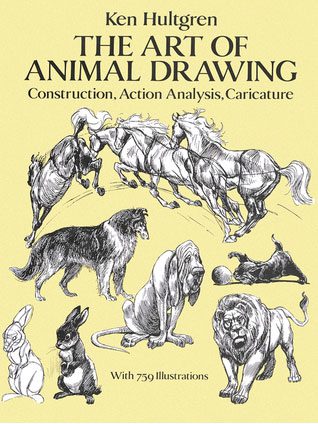
Join our newsletter
Be the first to receive news about upcoming books, projects, events and discounts!